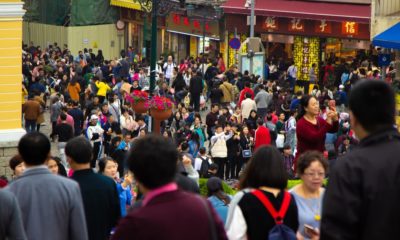Economic News
Consumers Drove the Economy Hot, But Set to Weaken in 2023
Published
3 years agoon
By
adminFor a year that promised a return to routine, 2022 delivered lots of curve balls to the American consumers.
Supply chains remained in disarray as ongoing snarls were exacerbated by Chinese lockdowns and Russia’s invasion of Ukraine, average US gas prices soared to levels not seen since the early 1980s, and interest rates quickly soared as the Federal Reserve dug in its heels and took a whatever-it-takes approach to rein in soaring prices.
Consumers armed with plenty of pandemic-induced pent-up demand and ample bank reserves kept the economy spinning throughout the majority of 2022. According to the Bureau of Economic Analysis, spending stayed above 2021 levels in November, coming in at 2%.
“Most people’s finances are probably better than we give them credit for,” says Ted Rossman, senior industry analyst at Bankrate. “However, I believe there are reasonable concerns that may not last.”
Consumer expenditure was stable for the majority of 2022. However, persistently high inflation has taken its toll, eroding the financial cushion. With interest rates set to rise in 2023 and economic instability on the rise, consumers may run out of cash at the worst possible time.
“A lot of folks have been able to stay up with their payments and save more; it’s just a question of ‘where do we go from here?‘” According to Rossman.
That might change rapidly if the historically low jobless rate rises, as the Federal Reserve and experts predict.
Resumption of pre-pandemic levels
During the pandemic, Americans’ personal savings rate reached an all-time high as many locked-down workers saved on the cost of their daily commute and other expenses and benefited from government handouts intended to promote spending. However, the household savings rate is now at 2.4%, the lowest since 2005 and the second-lowest in more than 60 years.
According to Federal Reserve data, household financial obligations (i.e. debt) as a percentage of disposable personal income reached an all-time low of 12.57% in the first quarter of 2021. As consumers rely more on credit cards and other forms of borrowing, that share has risen to 14.49%, significantly below the 40-year norm.
According to Federal Reserve data, credit card delinquencies were near historic lows as of September 30, with a 2.07% rate. That rate, however, is higher than the prior quarter and was achieved at the fastest rate on record, according to Fed data dating back to 1991.
Auto loan delinquencies, which had fallen to their lowest level since 2003, are rising to pre-pandemic levels; nonetheless, they are rising faster than they have in the previous nearly 20 years.
“Auto delinquencies appear to be the most troublesome area right now, more so than credit cards and mortgages,” Rossman added.
The major issue with vehicle loans is that the price increase [during the epidemic] caused many to overspend. He said that rate hikes haven’t helped.
“We’re seeing more people take out loans with $700 or $800 monthly installments and terms of five, six, or seven years,” he said. “It appears that many people have already over-extended themselves on this, and this appears to be leading to increased concerns about delinquencies and defaults, particularly in the auto industry.”
According to Edmunds.com, the average monthly payment for a new automobile was $703 in the third quarter, up nearly 26% from 2019.
Although delinquencies, defaults, and repossessions are rising from historic lows, they are not likely to reach “red-alert levels,” according to Jonathan Smoke, chief economist at Cox Automotive.
“The true worry in the market right now is a recession, not a wave of repossessions,” he wrote last week in a blog post. “We had anticipated an increase in loan defaults and repossessions, but long-term projections through mid-decade (2025) indicate that overall defaults and repossessions will remain within expected norms.”
Balance sheets are beginning to contract.
According to Rossman, the pendulum is swinging back from a point where many of these indicators were artificially low.
“Things don’t feel great with high inflation and higher interest rates, and it’s not ideal that the saving rate has dropped to only 2.3% at the present; but in terms of money that some individuals have in the bank, it’s a lot more,” he said.
Pandemic help, along with a sharp reduction in consumer spending during the pandemic’s peak, caused people’s savings accounts to expand. Fed economists anticipated that between 2020 and the summer of 2021, US households saved $2.3 trillion more than pre-pandemic trends. According to JPMorgan Chase, consumers have been draining those coffers to the tune of $1.2 trillion to $1.8 trillion.
“That trillion and a half dollars will run out some time mid-year next year,” JPMorgan Chase CEO Jamie Dimon said earlier this month on CNBC, warning that inflation is “eroding” the savings pile.
And, according to Rossman, Americans’ reliance on credit cards and other forms of financing, such as “Buy Now, Pay Later” installment loans, is expanding.
“[BNPL] may feel better than a credit card since it has a cheaper interest rate and a shorter period, but it may also tempt you to splurge,” he explained.
The forecast for 2023 is becoming bleaker.
Headwinds are gathering, which might put a damper on household spending, which accounts for the lion’s share of the US economy.
“The major engine of US growth — the consumer — is still operating, but three critical variables imply it will lose significant speed as we approach into 2023,” wrote Gregory Daco, EY Parthenon’s senior economist, in a note earlier this month. “First, the soft income trend will deteriorate more in 2023 as compensation and employment growth slow. Second, the so-called “savings slump is unusual and unsustainable. Third, the credit binge poses a genuine risk, particularly for lower-income households.”
According to EY Parthenon, consumer expenditure will level off in 2023 after increasing 2.7% this year. According to Daco, persistent inflation, tighter financial conditions, and a weaker global economy could tip the US into a mild recession in the first half of the year.
“With record low household sentiment and savings cushions rapidly diminishing, consumers will likely grow increasingly hesitant to spend in the coming months,” he said. “This will become clearer if labor market conditions deteriorate and household wealth is eroded by dropping stock prices and home values.”
But, while consumers are resilient, they are also restrained, according to Matt Kramer, national sector leader of consumer and retail for KPMG.
Consumers are “certainly making difficult decisions [and] pausing on the larger cost goods,” focusing on non-discretionary products, he said.
Among the changes he’s made are buying fewer gifts and looking for ways to save money. This frugality has extended to the buying of necessities. Discount stores like Walmart and Dollar General have reported an increase in wealthy clients.
“We may have a story of two years by 2023, with the first half being a bit challenged by economic headwinds but coming out of it in the back half with things looking more favorable and consumers being a little bit more eager to spend with the bright outlook that’s ahead,” Kramer said.
For More Economic News, Click Here.
You may like
Economic News
Globalization is a Critical Issue in Davos
Published
3 years agoon
January 18, 2023By
admin
Days long forgot.
A decade ago, political power brokers and corporate titans convened in the Swiss Alps under an optimistic banner, globalization. It was a time for “resilient dynamism,” declared the World Economic Forum‘s 2013 summit organizers. They argued that the globe has entered a “post-crisis” period following the travails of the global financial crisis. It was incumbent on the Davos elites to bring in additional reforms in the service of economic “sustainability” and “competitiveness,” recurrent WEF watchwords that tap into the liberal ethos that has long underpinned its proceedings, where doing good need not conflict with profit margins.
After ten years, there appears to be less optimism. Instead of a “post-crisis” time, it’s more usual to speak of a “permacrisis,” of a world teeming with calamity — war, climate catastrophe, energy price mayhem, inflation, epidemics of hunger and illness, political instability, and growing economic injustice. This year’s WEF theme, an impassioned plea for “cooperation in a fractured globe,” seemed to be more obsessed with the ruptures that have already occurred. Last week, WEF President Borge Brende told reporters that the meeting “will take place against the most complicated geopolitical and geoeconomic backdrop in decades.”
Issues that are still hounding the WEF.
Concerns about a probable global recession are high on the agenda. There’s also the perplexing issue of climate change, as well as the ongoing conflict in Ukraine and its ramifications, such as the snarling of the global grain trade, which contributed to the development of famine conditions in large parts of Sub-Saharan Africa. Underneath it all is a deeper Davos anxiety: few institutions are more inextricably linked to neoliberalism and the globalization movement than the conference. Where does globalization go in an age of rising nationalism and great power competition, when the United States itself is launching trade wars?
The Economist’s recent cover story, which attempts to describe the Davos zeitgeist each year, criticized the “new logic that threatens globalization.” It criticized the Biden administration’s “abandonment of free-market standards in favor of an aggressive industrial policy,” citing subsidy-laden programs to support the country’s green transition as well as new efforts to make the country a semiconductor manufacturing hotspot.
All of this, according to the historically liberal Economist, has “kicked off a perilous spiral into protectionism worldwide,” fraying the global order that the US spent decades constructing and securing in the aftermath of World War II. It may potentially jeopardize “liberal democracy and market capitalism’s causes.”
The Davos hosts want to maintain the status quo.
Tuesday’s launch panel, comprising economic historians Adam Tooze and Niall Ferguson, will debate “de-globalization or re-globalization.” The latter approach mirrors current developments, with governments and multinational corporations redirecting supply chains away from conflict zones and unfriendly states. It is visible with the exit of a large number of Western corporations from Russia and China.
“I would say we are in a re-globalizing moment,” Malaysian Trade and Industry Minister Tengku Zafrul Aziz told me at his country’s pavilion along Davos’ snow-lined central promenade. He believes that while companies and enterprises may benefit in the near term from shifting away from China and into Southeast Asian markets, the larger picture is more concerning.
“People are getting more compartmentalized,” he remarked. “In the long run, we are concerned about rising trade expenses.”
Notable absentees.
According to the forum, this year’s attendance includes more than 50 heads of state or government, 56 finance ministers, 19 governors of central banks, 30 trade ministries, and 35 foreign ministers, making it the largest gathering of political and business leaders ever.
The majority of the world’s leading economic leaders, though, are conspicuously absent. German Chancellor Olaf Scholz will be the only Group of Seven leaders to attend, with his European peers presumably keen to avoid the optics of rubbing shoulders with the global elite while their own populations deal with cost-of-living difficulties. The key officials from the Biden administration are US climate envoy John F. Kerry and US Trade Representative Katherine Tai, who, given the current state of affairs, may find herself in some heated discussions over the week.
Following a pause caused by the pandemic, China has dispatched its own high-level delegation, led by Vice Premier Liu He, who is scheduled to deliver one of the event’s major keynote addresses on Tuesday. It is a revival of Beijing’s engagement with the forum, albeit not at the level seen in 2017 when Chinese President Xi Jinping keynoted events with a speech championing globalization that portrayed China as an upholder of the liberal system. It was interpreted at the time as a declaration of intent by a leader eager to take the mantle of global leadership, as well as a thinly veiled jibe at the recently appointed ultranationalist Trump government bent on populist disruption.
That occasion at Davos was perhaps a watershed moment for Xi on the global scene.
His dictatorial hand has tightened at home in the years afterward, while many nations worldwide regard China under his leadership as a threat, if not necessarily a foe. Whatever the World Economic Forum’s pleas for discussion and collaboration, there is a growing consensus in the West that Xi’s ambitions for Taiwan must be checked. There is now an emerging consensus that China’s admittance to the World Trade Organization two decades ago — possibly the single most momentous event in the history of globalization — was a mistake.
In 2013, WEF organizers praised Russian Prime Minister Dmitry Medvedev’s participation as a national leader who grasped “global obligations.” Of course, Medvedev and Russian President Vladimir Putin, as well as the entourage of Russian billionaires and business leaders who used to throw some of the most expensive parties on the fringes of the forum, are now all persona non grata in Davos. The conflict in Ukraine will cast a shadow over the talks, with a large delegation from Kyiv, including Ukrainian First Lady Olena Zelenska, in attendance.
Looking into the future.
A large portion of the discussion has little to do with politicians’ or pundits’ doom-mongering. There will be hundreds of lectures and events highlighting various examples of private-sector innovation and collaboration on topics ranging from food security to youth education to forestry (WEF has pledged to restore and plant a trillion trees around the world). WEF organizers describe the forum’s attendees as enabling “systems positive change” and guiding the globe toward a better, more sustainable future in rosy technocratic language.
“There’s skepticism around Davos; they can say it’s a talk shop,” Penjani Mkambula, who works at the Global Alliance for Improved Nutrition on fortifying grains with minerals and vitamins in the developing world, told me. “However, there are numerous advantages that emerge. A lot of alliances are formed, a lot of work is done, and the effects are sometimes visible years later.”
For More Economic News, Click Here.
Economic News
Population in China Declines for the First Time in Decades, Alarms Starting to Ring
Published
3 years agoon
January 17, 2023By
admin
China’s population decreased for the first time in six decades last year, a historic reversal that is believed to signal the start of a long era of fall in its citizen numbers with far-reaching ramifications for the country’s economy and the rest of the world.
Economic Ramifications
The dip, the worst since 1961, the final year of China’s Great Famine, adds credence to forecasts that India would overtake China as the world’s most populous country this year.
According to the National Bureau of Statistics, China’s population would have decreased by approximately 850,000 to 1.41175 billion by the end of 2022.
Long-term, UN scientists predict that China’s population would fall by 109 million by 2050, more than double the decline predicted in 2019.
Domestic demographers are worried that China may become old before it becomes rich, stalling the economy as revenues fall and government debt rises due to rising health and welfare bills.
“China’s demographic and economic prospects are far worse than anticipated. China’s social, economic, defense, and diplomatic policies will all need to be adjusted” Yi Fuxian, a demographer, stated.
He went on to say that the country’s declining labor force and manufacturing slump would worsen high pricing and rising inflation in the United States and Europe.
Birthrate keeps on falling
Last year, China’s birth rate was 6.77 births per 1,000 people, down from 7.52 births in 2021 and the lowest rate on record.
The death rate was 7.37 fatalities per 1,000 people, the highest since 1974 during the Cultural Revolution, compared to 7.18 deaths in 2021.
Much of the demographic collapse is the result of China’s one-child policy, which was implemented between 1980 and 2015, as well as sky-high education expenditures, which have discouraged many Chinese from having more than one child if any at all, and had long-term effects on the population.
Following the release of the results on Tuesday, the data became the top trending subject on Chinese social media. One hashtag, “#Is it really necessary to have children?” received hundreds of millions of views.
“The primary reason why women do not want to have children is due to society’s and men’s unwillingness to take on the task of parenting children. Women who give birth have a significant drop in their quality of life and spiritual life ” Joyful Ned, a netizen, shared his thoughts.
Impact of regulations
According to population experts, China’s strict zero-COVID regulations, which have been in effect for three years, have harmed the country’s demographic outlook.
Since 2021, local governments have implemented policies to encourage families to have more children, such as tax breaks, extended maternity leave, and housing subsidies. President Xi Jinping also stated in October that the government would implement additional helpful policies.
However, thus far, measures have done little to halt the long-term trend.
Searches for baby strollers on China’s Baidu search engine fell 17% in 2022 and are down 41% since 2018, while searches for baby bottles have declined by more than a third since 2018. Searches for aged care facilities, on the other hand, increased eightfold last year.
In India, Google Trends reveals a 15% year-on-year growth in searches for baby bottles in 2022, while searches for cribs increased nearly fivefold.
For More Economic News, Click Here.
Economic News
China’s Quick Reopening Pace Brings a Mixed Bag of Emotions Globally
Published
3 years agoon
January 13, 2023By
admin
The quick reopening of China’s economy from COVID lockdowns brightens the outlook for global investors eager to leave behind one of the worst years on record, but it may also exacerbate the inflationary pressures policymakers think are subsiding.
The impact of the world’s second-largest economy reopening on financial markets, which suffered double-digit losses last year as inflation and interest rates rose, is critical.
Emerging markets, commodity currencies, oil, travel, and European luxury companies are among the top buying bets on recovery optimism.
It will undoubtedly be a rocky voyage. COVID instances, deaths, and the economic impact on China from epidemic infections have yet to be seen, but commodities prices are already rising, raising the likelihood of inflation.
For the time being, investors are focused on the positives, anticipating additional stimulus measures from Beijing with the health crisis and economic impact on China peaking in the first quarter.
“The reopening story is looking fairly positive, and… China is pouring a lot of credit and fiscal stimulus into the economy,” said Edward Al Hussainy, senior interest rate and currency strategist at Columbia Threadneedle, which oversees $546 billion in assets.
“That boost is permeating global asset values.”
The reopening of China also alleviates the sting of recessionary threats. Goldman Sachs forecasts the eurozone economy to grow by 0.6% this year, up from a previous projection of a decline.
According to Chris Iggo, chief investment officer for core investments at AXA Investment Managers, “Chinese demand will offset the story in the West…” as consumer demand and company spending have decreased, while interest rates have risen.
WINNERS
Emerging markets, which are expected to profit from tourism and trade with China, were at the top of the buy list.
The Thai baht was a favorite of Hussainy and other investors. It has risen to its highest level since March and is up about 5% since the beginning of December.
Prior to the pandemic, Chinese tourists accounted for a quarter of all annual visitors to Thailand.
Amundi, Europe’s largest investor, believes the reopening may signal a “turning moment” for emerging market shares, a trade also supported by BlackRock’s investment institute.
According to Goldman Sachs, company earnings in Malaysia, Singapore, and Thailand should increase.
Chile, the world’s largest copper producer, is another investment favorite. Its peso has risen 7% since early December, as copper prices have risen near $9,000 for the first time since June.
According to BlueBay Asset Management fund manager Zhenbo Hou, the commodity-driven Australian dollar could appreciate further.
HOLIDAY?
Prior to the pandemic, China was the world’s largest outbound travel market.
Chinese customers “will rush to Beijing International Capital Airport and flee the country as quickly as they can because they want to travel,” according to Alison Shimada, head of overall developing markets at Allspring Global Investments.
Travel may also boost European luxury stocks, as Chinese demand has dropped since the outbreak began, according to UBS, accounting for approximately 17% of industry sales vs 33% in 2019. This should increase valuations.
LVMH shares (LVMH) reached a new high this week.
The reopening of China was expected to weaken the safe-haven currency while benefiting the euro. China is the European Union’s most important trading partner, accounting for around 16% of total goods trade.
According to Barclays analysts, China’s slowing was responsible for more than half of the euro’s loss against the dollar last year.
According to them, the reopening boosts the outperformance of European stocks and calls into question the consensus underweight strategy. UBS is also bullish on European materials, industrials, and consumer discretionary stocks.
CAUTION ON INFLATION
However, the boost from China’s reopening raises fears about inflation.
China is the world’s largest importer of oil and other commodities; oil prices have jumped 10% since mid-December to almost $84 per barrel.
“One thing we need to keep an eye on is if China’s resurgence adds to global inflationary pressures,” AXA’s Iggo added.
The aim is that the global economic slowdown will offset China’s increased commodity consumption, reducing the inflationary impact.
According to Goldman Sachs, a return to regular travel and transportation behavior in China might increase oil demand by 1.5-2 million barrels per day. Still, slower global growth implies oil prices won’t reach $140 highs until 2022.
“At this point in time, the rate hike is really starting to have the anticipated impact on inflation, which I think should play out over the course of the year, even with China reopening,” said Jason Pride, Glenmede’s chief investment officer of private wealth.
For More Economic News, Click Here.












You must be logged in to post a comment Login